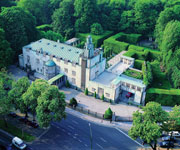Called back to Belgium on the death of his father, Stoclet succeeded him at the head of the Societe Generale, a major Belgian bank. He then decided to establish his family residence in Brussels, calling in Hoffmann and his Secession colleagues so that the group's artistic and architectural principles could be applied unhindered.
The specification was entirely functional. In addition to housing the family, the residence was to provide a setting for a large art collection; it was to permit musicians and artists to give private concerts; it was also to offer the best possible conditions for welcoming distinguished guests and friends. Hoffmann and the artists of the Secession were given a free hand, but they had numerous meetings with Stoclet, for whom the construction of the residence was the accomplishment of a work of art in which he was participating both aesthetically and intellectually.
At the time of the commission Hoffmann was at the pinnacle of his art. Not only was his own architectural work already widely acclaimed, it was he who had designed from the outset the exhibitions of the Secession, of which he was one of the co-founders. He was also a teacher, which allowed him to have a significant influence on the new generation of artists from Vienna and more widely from Central Europe. In the critical spirit of the Secession, which aimed to renew the principles of an Art Nouveau movement that was increasingly influential at the time, Hoffmann had already designed several remarkable villas and residences; he was just completing the Purkersdorf Sanatorium.
The Stoclet project, on which no restrictions would be imposed, came at just the right time: Hoffmann was able to gather around him the most outstanding creative members of the Viennese artistic movement. He was able to advance and take further his stylistic research, moving even farther away from the initial influences of Art Nouveau and the Arts and Crafts movement, towards an exaltation of simple and geometrical forms, an austere primitive ideal, and total integration of the different art forms to serve the project. The same idiom is in evidence in the exterior and interior architecture, in the decoration and the furniture, and in the gardens and the approaches.
Designed in 1905, the House was built without interruption from 1906 to 1911. The Stoclet family occupied the mansion continuously as its private residence until 2002, when the Baroness Annie Stoclet died. Since then the House has been managed by the real estate company 'Suzanne and Adolphe Stoclet' (SAS), the directors of which are the descendants of the founder and heirs of the House. Today the building is only permanently lived in by two caretakers.
The House has not undergone any major change in its history. There have been minor alterations of a functional or technical nature, and maintenance work has been carried out to preserve its integrity. The main changes made are as follows:
The German occupation authorities removed the bronze elements from the roof during World War I. These were afterwards replaced by the owners in conformity with the initial plans.
The entrance porch leading into the street was enlarged in 1954 when the garden was extended by the purchase of an adjacent plot.
Terrace waterproofing works were carried out in the late 1980s.
In the 2000s, the timing of the entrance porch threshold was replaced, and the door and window frames of the west and then the south facades were repainted; the wooden garden shed was rebuilt according to Hoffmann's plans and new boilers were installed.
The electrical wiring was brought into compliance with standards in 1950, and again in 2006.
No change has been made to the interior of the building, apart from the restoration of some items of furniture and the replacement of some furnishing fabrics, in conformity with the originals. Some carpets and light fittings have been placed in the attic, where they await restoration.
Browse All UNESCO World Heritage Sites in
Belgium. The original UNESCO inscription
Here!!!










No comments:
Post a Comment